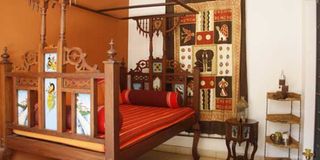Local design scene changing as new ideas gain acceptance

The fact that most of the current homebuyers are young people has also changed the dynamics in interior décor. The functionality of the entire house has become very important. PHOTO | FILE
What you need to know:
- For instance, interior walls can now be painted yellow, orange, purple or even green, colours previously deemed inappropriate by local designers.
- Property expos have also opened up the minds of consumers, but perhaps it is the use of African fabrics that has become the signature theme in most of the latest design trends, such as the African-with-a-touch-of-urban modern theme.
- She notes that the media have contributed to this, particularly the Mexican soap operas. “I have heard clients describing what they have seen – the nicely done living rooms, kitchens, dining areas, bedrooms, bathrooms.
In the last few years, many buildings have come up in Nairobi and other urban areas in the country, thanks mostly to devolution. Notably, a number of them were designed by foreign architects and designers.
The result has been a knowledge and technology transfer, mainly from the West.
“This [technology transfer] has opened the eyes and minds of local interior designers, and with it the receptivity of new ideas,” says Ms Anne Christine Mwaniki, the team leader at Treasure Residence Décor. “Some of the concepts are very bold and have challenged the norms set by local designers, making them accept trends that they once shied away from.”
For instance, interior walls can now be painted yellow, orange, purple or even green, colours previously deemed inappropriate by local designers.
“Today, I even desire to go against the grain and have all the primary colours in my living room. It is a cardinal rule in design not to have red, green and yellow in one setting, but look, I can already visualise the effects that I want to achieve; I just need to be bold enough to do it,” says Ms Mwaniki, who also freelances.
Another notable influence is the shapes of buildings.
“The shapes that architects adopt also influence the interior design of a building. For instance, if a window is semi-circular or triangular, the design of the curtains, their rods and boxes must conform with that,” Ms Mwaniki says.
The same applies to interior walls with unusual shapes, which can be replicated in artwork pieces, furniture or other items.
MEXICAN SOAPS
“However, interior designers do not always have to a conform with architectural designs, but can use them to create uniformity and then break that in an interesting manner that tells a story,” Ms Mwaniki says.
Notably, the public also wants things done differently.
“You go to design someone’s house and there are just so many ideas to work with within their space. And they are accepting that all these ideas be implemented. It is interesting,” Ms Mwaniki says.
She notes that the media have contributed to this, particularly the Mexican soap operas. “I have heard clients describing what they have seen – the nicely done living rooms, kitchens, dining areas, bedrooms, bathrooms. They enquire how this can be achieved in their space,” she says.
Property expos have also opened up the minds of consumers, but perhaps it is the use of African fabrics that has become the signature theme in most of the latest design trends, such as the African-with-a-touch-of-urban modern theme.
“For instance, on curtains, a small piece of African cloth can blend with plain cloth,” Ms Mwaniki notes. A similar effect can be achieved on sofa sets, table tops, bedcover designs, cushions and seat covers.
“A kitenge centre piece can be used on tabletops, pouffes and cushions,” she offers. “There are so many ways of using a fabric from one genre to transform items such as bedcovers, pillow cases and lampshades.”
The latest trend in sitting rooms is having a specific colour theme, which includes the walls and flooring, and sometimes also the seat covers, cushions and carpet. These can be matched with accessories like flower vases, sculptures, cushions, sheers and wall hangings.
As a result, paint has become important, although one can also use wallpaper. “From experience, I know painting is less expensive than wallpaper as it allows you the freedom to achieve any design effects,” Ms Mwaniki notes.
Besides, paint is now more affordable, and there are even textured ones that can be used to imitate wallpaper effects.
Another new influence is the open-plan kitchen “You can only make the kitchen more functional and exciting,” enthuses Ms Mwaniki.
The fact that most of the current homebuyers are young people has also changed the dynamics in interior décor. The functionality of the entire house has become very important, Ms Mwaniki says. For instance if it is a young family, blue and pink themes work well, but not white. For newly-weds, the windows need not show much; they should have heavy curtains to offer some privacy.
But the key determinant of interior décor is personality. Bold people will go for bright colours like orange, red, purple, bold shapes and very daring patterns.
“If someone likes keeping up with new fashion, I know they are not afraid of trying out anything new,” says Mwaniki. Meanwhile, introverts will play it safe with pastel colours.





